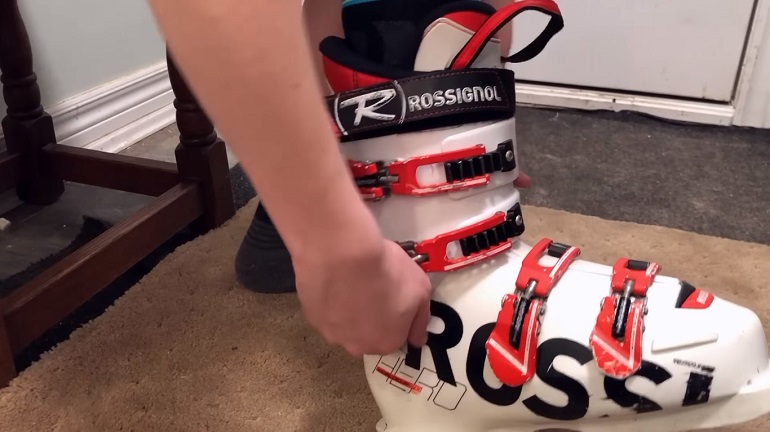Skiing is one of the most thrilling winter activities, but one thing that can put a damper on your mood is uncomfortable ski boots. No one wants torturous boots and experiences packing up early just because they couldn’t kick and scream their way into the boots.
So, how to face this issue? Fear not, my friend, for I am here to guide you through the process of making your ski boots feel like a party.
Without further ado, let’s go and find out multiple ways you can make your new pair as comfortable as a pair of fuzzy slippers. No more sore feet!
What Should Ski Boots Feel Like?

To answer your question properly, I’d like to start with what ski boots should NOT feel like. In clear words, if your feet feel like they are in a brutal grip or like you are wearing heavy metal blocks on your feet, something is definitely not right.
Since you are going to wear your boots for long hours, they should fit snugly instead of giving you a hard time. You don’t want to depower yourself and empower a mere shoe pair, right?
Do you want to enter or exit the ski area after asking for permission from someone or something? Freedom is the oxygen of the soul, so you better not strangle yourself.
Enjoying freedom on the snowy terrains when you are away from all the drama and chaos is the best experience ever. I’ve experienced it, and believe me when I say I felt like a knight in shining armor. Meet me; I’m Dobby. Dobby has no master. Dobby is a free soul. And Dobby likes to make life easy.
Let me enlighten you on something; if your shoes fit snugly, you will be able to move however you desire. But if the case is otherwise, when your body moves, your boots will not follow the movements.
A pro tip for a snug fit is to ask for a size smaller in ski boots than your normal shoe size. It will prove a good starting point in your hunt for the right size boots.
How Do You Stop Ski Boots from Hurting?

The wrong size can put a damper on your ski experience. You know, those tight, downright painful, and super constricting boots tend to make you quit before you even hit the slopes.
And you clearly didn’t spend hundreds of dollars on that expensive ski gear just to give up before you even gave it a try.
Let’s explore some ways by which you can stop your boots from hurting your feet.
Wear Thinner or Thicker Socks

So, the first step for a comfortable ride is to purchase a terrific pair of ski socks besides necessary layering for extra warmth. Wait, what? Were you thinking of using that regular pair at home? No, Andrew. That pair will not do in a ski resort!
Trust me; your feet will thank you for investing in a fresh and healthy pair of ski socks that meets the skiing requirements.
Before addressing the question of how thick or thin your ski socks should be, you should first address the question of composition and material. Long story short, your pair of ski socks should be made of merino wool or similar material like that instead of cotton.
I mean, you don’t want to accumulate sweat and moisture in your boots, right? The cotton socks not only provide a swimming pool to your feet but also tend to dry late. On the flip side, the merino wool socks do not accumulate moisture but rather wick it away and keep your feet dry.
Now let’s switch to the question of thickness and thinness. It is a matter of personal choice. While some people like to wear extra thick socks for a padded feel, some tend to wear thin socks for precise transfer of power. Just so you know, a thinner sock absorbs your movements better while keeping you warm as well.
If your ski boots are freshly bought from a ski shop, and the sole feels too hard under your feet, you can wear extra thick socks to mitigate the hardness. Or you can wear your socks and boots at home to break in your new ski boots beforehand.
Anyway, another pro tip for a comfortable ski day is removing boots between your rides, like during a snack break. Doing so releases the feet from the continuous tense state, and your feet stay pain-free even at the end of the day.
Wear the Correct Flex Ski Boot
Here’s a hack for you; if you are a newbie, go for a softer flex ski boot for beginners. However, if you are a professional, you know what to do.
You will find ski boots with different flex ratings on the market, and these ratings tell you about the flexibility of a pair. The flex rating usually ranges from 60 to 180. The smaller the value, the softer the flex. On the other hand, the larger the value, the stiffer would be the flex.
Tips for Making Your Ski Boots Comfortable
Let’s explore some quick tips on making your ski boots super-friendly.
Invest in a Boot Warmer

If you want to make your boots more forgiving, then you better make use of boot heaters available in the market. You know, the insulation already provided by the manufacturer is not always enough for you as the weather tends to fluctuate a lot.
One moment you are giving an Oscar-winning performance, while the other moment, you are shivering your way out.
Adding heat stacks not only provides warm air to liners but also boosts your performance. If you own an aftermarket footbed, you can stick a foot heater to it.
If the ski boot warmer you are using is an electric model, a wire will run through the heat-molded liner of the shoes and connect to a battery pack attached to the Velcro strap.
While some people prefer electric models, others prefer ceramic models. Truth be told, both versions have their pros and cons.
An electric model will make your shoes toasty warm very fast but tend to damage the boot liner. On the other hand, a ceramic model will heat shoes overnight but doesn’t damage anything.
Modify Buckle Placement

Modern ski boots come along with micro-adjustment options for ease. I mean, you don’t want to strangle your feet, right? However, in some cases, you are not facilitated with enough screws and slots for customizability, and that’s a big ‘NO’ for most skiers.
Custom adjustment is a must-have because it makes all the difference. If your boots are too tight in certain areas, you need to open them a bit from those specific points by making adjustments in buckle placement. Move them up or down a notch to alleviate pressure points.
A Racer’s Secret

Heel lifts are your life savior! Have you noticed some skiers tend to put some foam pads in their shoes and tape them to the back? Well, those pads are called heel lifts, and they make a big difference when it comes to comfort.
The heel lifts reduce the pressure on your heels and keep your feet from getting blisters and other foot issues.
Power Straps
If you are after extra stability on the mountain slopes because you are clever and you know that balance and skiing go hand in hand, then congratulations! You are soon to become a pro in this snow sport.
Those extra straps that you can add to your boots provide impeccable support and control that no other thing can provide. Believe me, there is no substitute for that extra strap for proper fit.
Top Complaints about Ski Boots
Let’s have a look at some common issues the riders complain about while wearing ski boots on the slopes.
The Fit Is Too Tight

In a ski store, you should ask for a size smaller as a start-up, then as you slide your feet into the boots, just flex forward. This way, you will make extra space for toes.
Always stay careful while deciding on a particular size. The size chart of one brand differs from the other and thus offers varying widths. You should decide wisely, and no pair should cause you severe pain by hindering circulation to your feet.
While visiting ski shops for new boots, always remember to refer to the size chart, size down your ski boots, try them on, and break in before the skiing holiday.
The Hard Boot Is Causing Blisters
Who needs a full-body workout when you can get blisters from skiing in hard boots? Duh! You certainly don’t want it! So, what’s the solution to painful rubbing and uncomfortable boots?
The hack is to purchase a good quality pair of socks with extra padding and breaking in your shoes before your first day for minimal stiffness.
There Is No Arch Support
“No arch support? Might as well just ski in a pair of Crocs or street shoes. Well, that’s the reaction of many skiers.
Believe me when I say even the most expensive brands don’t always provide it. But there is one solution: a pair of custom footbeds designed specifically with your foot in mind will suffice.
Conclusion
To summarize it for you, ski boots should feel like a party for you, like a warm hug from a loyal friend or a well-loved pair of jeans.
If they are doing their job right, they might make you feel invincible, like you can conquer whatever comes your way.
0 Comments